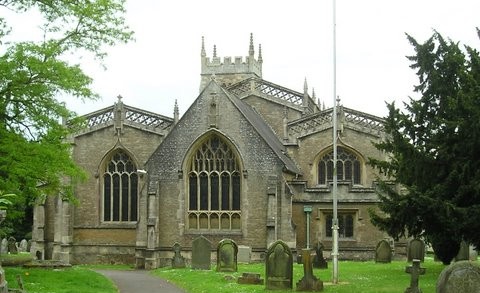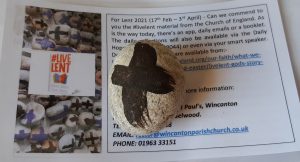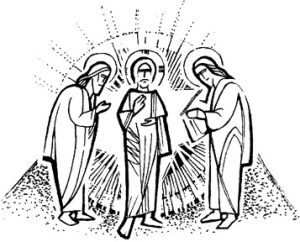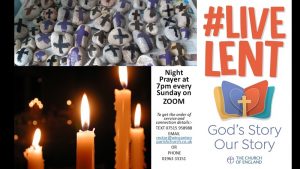Link to video service for Lent 2 https://youtu.be/iqqPTC9s9q4
Church of England Service for the week – Featuring the Archbishop of Canterbury, Hannah Steele and Stephen Hance (talking about the #LiveLent stuff) https://t.co/WTxcstQoUu?amp=1 (from 9am on Sunday)
Genesis 17: 1-7, 15-16 and Mark 8: 31- end
You will have often heard jokes that begin with the question, ‘There is good news and bad news, which would you like first?’ A couple of weeks ago I came out of a church meeting during which my husband Gary had taken a phone call, and he asked me this question. The call had been to ask me to go for my Covid vaccination – definitely good news, but the bad news was that we had to be at Verrington Hospital at 8.30 on Saturday morning. Those of you who know me will know that I am really not good at mornings! You may also be impressed to know that we were the second to arrive, even before the centre had opened and that we have now joined the growing number of those who have had the first dose of the vaccine.
Our readings today seem to be very much divided into the good and bad news category. In the first reading Abraham is promised by God that although he is old and his wife can no longer bear children, they will still have a child and that Abraham’s descendants will be more that anyone can count. God also gives them new names which have meanings to show that they will be father and mother of many nations. This is not the first time that God has made this promise to Abraham – with a rough count from my bible I can find six previous occasions when God has either promised descendants to Abraham or told him of the land that they will occupy. This is also after the birth of Ishmael which came about when Sara and Abraham decided that they needed to take a hand in helping God to keep his promise.
The bible repeatedly tells us too that Abraham believed this promise of God’s although it seems that Sara was more sceptical. I am not sure that I would have had the faith of Abraham, particularly as it seems that God’s promise took a few years to be fulfilled, and each passing year would have made it seem less likely.
It is interesting to note that Abraham lived about as many years before Jesus as we live after him, and so by the time Jesus came, his people and their worship of God had had as long to organise itself in the way the people wanted it as the Christian church has had now. We do love our organised structures, our proper ways of doing things, our rules and regulations about what is and isn’t right. Our judgements about who will fit in and who won’t.
In our gospel reading Jesus is teaching the disciples about what is to happen to him. This is actually happening just before his transfiguration that we read about on the Sunday before Lent, and which as Alison pointed out to us marked a turning point in his ministry – up to then he had been largely teaching in the north of Israel around Galilee, but now he is aware that he must look toward Jerusalem and all that is to happen there. Poor Peter – he seems to be very much a man of his time. He has been well educated by the priests and rabbis about the faith of his people and he knows how the story is meant to go. Despite all that the prophets have said, he is looking for someone to save the nation from their conquerors and he has decided that Jesus is it. Today’s teaching does not fit with the plan at all, and Peter is quick to tell Jesus so. There are no grounds here for us to feel superior though – so many times in history and now do we have trouble in marrying up what seems the obvious right thing to do with the thing that God seems to be telling us. I am sure God is still saying to us as he said through Isaiah in chapter 55 ‘For my thoughts are not your thoughts,
nor are your ways my ways, says the Lord’[1]. We are sadly still guilty of telling God where He got it wrong!
The problem we have with the two readings today is that even we, who know how the story went on, do not see that the teaching in today’s gospel is just as much good news as the promise God made to Abraham. This is the good news that gives us hope – makes us into a people of hope. Just as Dame Julien of Norwich was able to say at the height of the bubonic plague ‘all shall be well and all shall be well and all manner of things shall be well’ so too we can say the same as we are hopefully able to see the possibility the end of a time of lockdown that seems to have lasted for ever. We can know, as Abraham and Julian believed ‘hope does not disappoint us, because God’s love has been poured into our hearts through the Holy Spirit that has been given to us.’ This is the season of Lent, and just as surely as every winter ends with the beauty and joy of spring, so every lent ends with the miracle of Easter. We need Lent, just as we need Good Friday, because without them there could not be an Easter Sunday.
We are studying the beatitudes in our Lent course, and at the end of the beatitudes Jesus tells us that we are to be the salt of the earth. We all know that if we cook something in water, the salt that is naturally present dissolves out and leaves the food tasteless – and so we add salt. In the Message translation of the bible, this passage is put this way: ‘Let me tell you why you are here. You’re here to be the salt-seasoning that brings out the God-flavours of this earth. If you lose your saltiness how will people taste godliness?’[2] I think we are not only here to be salt, but all the flavours that make life exciting – perhaps pepper, ginger or chilli or mustard. God has given us a wonderful earth on which to live a hope filled life – lets not paint it grey and make it appear tasteless. It may be Lent, but we will always be an Easter people.
Let’s finish by saying the prayer from our Lent cards together:
May our journey this Lent be as an adventure: unpredictable, exciting, challenging.
May our minds race, our hearts sing and yet may we ever find in our travelling a stillness that is your presence with us; leading us on to Jerusalem where the truth of your eternal love is revealed on a cross and at an empty tomb.
We pray in Jesus’ name, Amen
New Revised Standard Version Bible: Anglicised Edition, copyright © 1989, 1995









